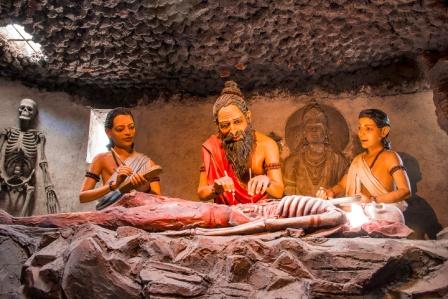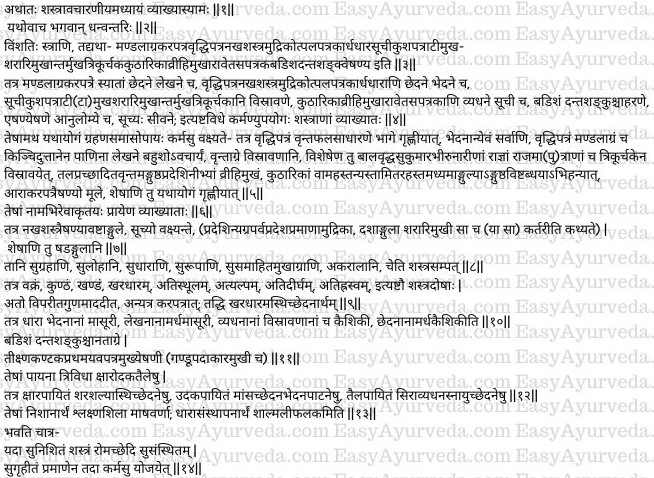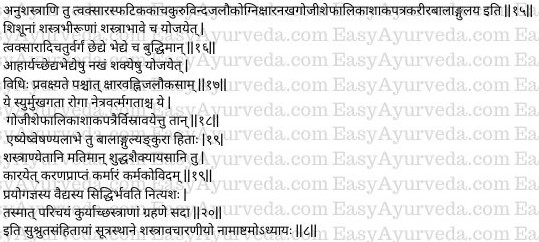Sushruta Samhita Chapter 8 Shastravacharaniya Adhyaya
This article explains Sushruta Samhita Sutrasthana Chapter 8 “Shastravacharaniya Adhyaya”- Sharp instruments and their usage.

Table of Contents
Shastravacharaniya Adhyaya
Now, we will propound the chapter by name Sastravacaraniya- usage of sharp instrument; as revealed by the venerable Dhanvantari.
Read – Shastra – Surgical Instruments Of Ayurveda: Astang Hriday Sutrasthana 26
Sastranama – Sankhya
Names and number sharp instruments
Sastras (sharp instrument) are twenty in number – these are
| Sl No | Name of the Shastra (sharp instrument) | Equivalent to |
| 1 | Mandalagra Sastra | Circular Knife / Round head knife / Decapitating knife |
| 2 | K Karapatra Sastra | Bone saw |
| 3 | V Vrddhipatra Sastra | Scalpel / Dissecting knife |
| 4 | Nakha Sastra | Nail parer |
| 5 | Mudrika Sastra | Finger knife |
| 6 | Utpalapatra Sastra | Lancet |
| 7 | Ardhadhara Sastra | Single edged knife |
| 8 | Suci Sastra | Needle (straight, half curved, fully curved) |
| 9 | Kusapatra Sastra | Paget’s knife / Bistoury |
| 10 | Atimukha Sastra | Hawkbill scissors / lancet |
| 11 | Sararimukha Sastra | Pair of scissors |
| 12 | Antarmukha Sastra | Curved bistoury |
| 13 | Trikurcaka Sastra | Trocar / brush |
| 14 | Kutharika Sastra | Axe shaped knife |
| 15 | Vriihimukha Sastra | Trocar |
| 16 | Ara Sastra | Awl |
| 17 | Vetasapatra Sastra | Narrow claded knife / scalpel |
| 18 | Badisa Sastra | Hook |
| 19 | Danta Sanku Sastra | Tooth scaler |
| 20 | Esani sastra | Sharp probe / Probe director |
Benefits
Benefits of sharp instruments in surgical practice
Among these sharp instruments –
Mandalagra and Karapatra Sastras are meant for Chedana (excision, cutting) and lekhana (scarifying, scratching).
Vrddhipatra, Nakhasastra, Mudrika, Utpalapatra and Ardhadhara are meant for chedana (excision, cutting) and bhedana (cutting, dividing, and separating).
Suci, Kusapatra, Atimukha, Sararimukha, Antarmuka and Trikurcaka are for visravana (draining out fluids).
Kutharika, Vrihimukha, Ara, Vetasapatra and Suci are for Vedhana (puncturing, pricking).
Badisa and Dantasanku are meant for Aharana (extraction).
Esani is used for Esana (probing, searching) and anulomana (draining).
Suci is meant for Sivana (suturing).
Thus, was described the uses (purpose) of the sharp instruments for the eight kinds of surgical techniques.
Read – Methods Of Surgical Training Elaborated In Ayurveda
Sastra grahana vidhi
Mode of holding the instruments
Now we shall expound the method of holding each of these sharp instruments while conducting surgical procedures –
Vrddhipatra Sastra should be held in between the Vrnta (handle) and Phala (blade). The same is the method of holding other sharp instruments meant for bhedana (cutting, incising).
Vrddhipatra and Mandalagra should be held by the hand slightly raised up, and shall be used many times for the purpose of lekhana (scraping).
The sharp instruments used for the purpose of visravana (draining) should be held at the tip of the handle (of the instrument).
Visravana (Draining) should be done by using Trikurcika Sastra, especially in children, the aged, those of tender physique, those afraid of sharp instruments, women, king and princes / king- like persons (royal people).
Vrihimukha sastra should be held in the palm with its handle concealed. The instrument shall be held with thumb and index finger (in the middle).
Kutharika should be held in the left hand. Stroke should be given on it by the middle finger of the other hand (right hand) released after holding it with your thumb.
Ara, Karapatra and Esani should be held at their root. The remaining instruments should be held as suitable for the purpose.
Note:- Every sharp instrument has three parts, viz,
- Dhara (sharp edge or the blade),
- Phala (the body of the blade / the chief working part) and
- Vrnta (Varanga) – handle-hind part. For more details of the instruments mentioned above, refer to the appendix.
Read – Foreign Body Removal – Ashtanga Hrudaya Sutrasthana 28
Sastra Akriti
Shape of Instrument
The shapes of these sharp instruments are generally described (implied) in their name itself.
Sastra pramana
Size of the instruments
Nakha sastra (nail parer) and Esani (sharp probe) are of eight Angula (16cm) each.
Suchi (needles) will be described later: (vide chap 25).
The size of Mudrika Sastra (finger knife) should be such that it would allow insertion of the first phalanx of the index finger.
Sararimukhi Sastra should be ten Angula (20 cms). This is also called kartari (scissors).
All other Sastras should be of six Angula(12 cm) in length.
Read – Sushruta’s 8 Types Of Surgical Procedures – Astavidha Shastra Karma
Sastra Sampat
Merits of the instruments
A good sharp instrument should essentially comprise of the below mentioned qualities –
- Sugrahani – should have a good handle so that it is easy to hold (while conducting the surgical procedures)
- Sulohani – should have been made using good metal
- Sudharani – should have good blades
- Surupani – should have good appearance
- Susamahata mukhagrani – the front portion of the face of the sharp instrument should be well placed
- Akaralani – should not have teeth (serrated edge) / scratches
Sastra Dosa-Demerits
Below mentioned are the eight demerits (undesired qualities) of a surgical instrument –
- Vakra dhara – crooked / bent cutting edge
- Kuntha dhara – blunt cutting edge
- Khanda dhara – broken cutting edge
- Khara dhara – hard / rough cutting edge
- Ati Sthula – very thick, very big
- Atyalpam – very small, very thin
- Atidirgha – very long
- Atihrsva – very short
So, the instruments having opposite qualities of those of the above mentioned shall be used. But there is an exception with Karapatra (saw). Its edge should be hard and rough since it should be used for cutting the bones.
Read – Yantra Instruments used in Ayurveda: Ashtanga Hrudayam Sutrasthana 25
Dhara pramana
Size of the edge (blade)
The Dhara (sharp edge of the blade) of instruments used for Bhedana (incising / cutting) should be of the size of the masura – lentil.
The dhara of instruments used for lekhana (scraping, scarification) should be of the size of ardha masura – half lentils.
The dhara of instruments used for vyadhana (puncturing) and visravana (draining out fluids) should be of the size (thickness) of the kaishika – thin like a hair.
The dhara of instruments used for chedana (excising) should be of ardha kaishika – half of the size (thickness) of a hair.
Notes:- Instruments meant for Bhedana are Vrdi Patra, Nakhasastra,Mudrika sastra, Utpal Patra and Ardhadhara; those meant for lekhana are Mandalagra and Karapara; those meant for Vayadhana are Kutharika, Vrihimukha, Ara and Vetasapatra and those meant for Vaisravana are Esani.
Badisa, Dantasanku and Esani
Badisa (hook) and Dantasanku should have their tip slightly bent. Esani is of three types –
- Tiksna kantaka – that having the face resembling and pointing like a sharp thorn
- Prathama yava patra mukha – that having the face resembling the first leaf (fresh leaf) of barley (which is germinating)
- Gandupada akara mukhi – that having the shape and mouth resembling that of an earthworm
Notes:- Dalhana, the commentator explains that Esani (sharp probe) is of three kinds; one with a sharp point; the second in the shape of a barley leaf and third in the shape of the mouth of an earthworm.
Read – Shashti Upakrama Meaning, Classification, Clinical Significance
Sastra Payana
Tempering of instruments
The methods of tempering of these sharp instruments are of three kinds viz,
- Kasra – tempering in caustic Alkali,
- Udaka – tempering in water and
- Taila – tempering in oil
The instruments tempered in alkalies are meant for cutting / removing the foreign bodies stuck in the body in the form of arrows and cutting (excising) the bones.
The instruments tempered in water are useful for splitting, cutting and tearing of muscles.
The instruments tempered in oil are useful for puncturing the veins i.e., venesection and excising the ligaments.
Notes:-Procedure generally adopted for tempering is to make the blade of the instrument red hot by holding it in flame and immediately dipping it in a liquid for a few seconds and removing it out. By tempering, sharpness of the blade becomes augmented and more effective in its performance.
Nisana – Sharpening
Generally, a smooth stone slab of the colour of black gram is used for sharpening the blades of sharp instruments.
A pod of Salmali fruits (with silk cotton inside) shall be used for maintaining the sharpness of the edges of the sharp instruments (for keeping the sharpened blades).
Right time to use the sharp instruments
One verse here:-
The sharp instrument should be used in surgical activities –
- only when the blade of the instrument has been sharpened well such that it can split a hair
- when it is well fixed
- when it is held properly (by the surgeon) and
- when it is of appropriate size
Read – Procedure of surgical operation: Ashtanga Hrudaya Sutrasthana 29
Sanskrit Verses


Anusastra
Accessory instruments
Below mentioned are the anusastras – accessory instruments –
- tvak sara – bamboo
- sphatika – rock crystal
- kaca – glass pieces
- kuruvinda – corundum stone
- jalauka – leech
- agni – fire
- ksara – caustic alkali
- nakha – nail
- leaves of goji (gojihva), sephalika, saka and karira
- bala / vala – hair
- anguli – finger
Areas of using anusastras (accessory instruments)
The physician should use anusastras – accessory instruments including bamboo, rock crystal, glass piece, corundum stone etc for conducting surgical procedures like excision and splitting in
- children (who are naturally scared about instruments and sometimes the sharp instruments shall be harmful for using in kids)
- persons who are afraid of sharp instruments
- the absence of or non-availability of required sharp instruments during the time of surgical procedures
The nails shall be used in extraction, excision, and cutting and in any procedures where they can be used (as and when possible).
The procedure of using caustic alkalies, fire and leeches will be described later on (in the chapters ahead).
The leaves of goji, sephalika and sakapatra shall be used for draining the diseases of the mouth and of the eyelids of their fluid accumulation.
One should use esani (probe) for esana karma (probing, exploring). In the absence of esani, probing shall be done using hairs, fingers or sprouts.
Read – Leech Therapy Procedure, Benefits, Side Effects, Treatment
Sastra Nirmana
Manufacture of the instruments
The intelligent physician should get the instruments manufactured from pure and strong / hard iron (steel). These instruments shall be prepared by a blacksmith who is experienced and skilled in his work.
Secret of success in surgical practice
The surgeon who is well versed and experienced (in use of sharp instruments, accessory sharp instruments, blunt instruments and accessory blunt instruments) in the surgical procedures will find success in conducting surgical procedures and curing the patients only if he practices these surgical techniques daily and regularly. Hence the physician / surgeon should always practice the methods of holding the sharp instruments correctly.
Thus ends the Eighth chapter by name Shastravacharaniya, in Sutra Sthana of Susrutha Samhita.









